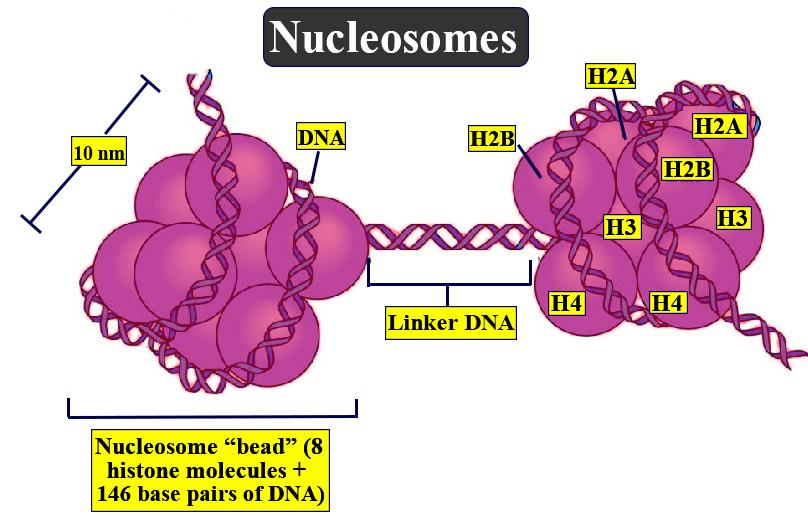
Nucleosome is made up of
(a) Histone protein and RNA
(b) Histone protein and DNA
(c) Non-histone protein and histone protein
(d) Phospholipid and protein
Answer
440.7k+ views
Hint: They are the packed form of genetic material as in the DNA changes into the chromosomes. The nucleus of the eukaryotic cell contains this packaged form where the chromatid threads are arranged repeatedly giving a beaded appearance.
Complete answer:
The human nucleus is only 6 micrometers in diameter and yet it contains 1.8 meters of DNA which are distributed among 46 chromosomes. So each chromosome contains a single DNA molecule of about 1.5 inches long. The chromosomes are long enough so it is quite difficult to be present in the nucleus thus it is present as a coiled structure.
The organization of the DNA is arranged in a well-fitted manner inside the nucleus instead of the non-systematic crumbled DNA found as a ball. The DNA is formed after the molecular interaction with the proteins resulting in the DNA packaging. This will also result in the gene combination that includes the DNA and the proteins and then result in the formation of the chromatin which is in the form of compact fibers. These chromatin fibers are arranged around the histone proteins and bind them together. These histone proteins are the amino acids that are positively charged. The octamer is formed when the eight histones are surrounded or wrapped around the DNA molecule. This structure will form a nucleosome which appears to be a bead-like structure. A typical nucleosome normally constitutes around 200 base pairs of the DNA helix while the human nucleosome will constitute 146 bp of the DNA helix along with the histone proteins.
The histones are positively charged so that they can neutralize the DNA as it is negatively charged. The histones found in the nucleosome structure are of five types,
So, the correct answer is ‘Histone protein and DNA’.

Note:
Nucleosomes were earliest discovered as particles in the electron microscope by Don and Ada Olins in 1974. In the human body, each cell constitutes around 30 million nucleosomes. The gene expression will become selective since the nucleosome will be wounded by the inactive DNA.
Complete answer:
The human nucleus is only 6 micrometers in diameter and yet it contains 1.8 meters of DNA which are distributed among 46 chromosomes. So each chromosome contains a single DNA molecule of about 1.5 inches long. The chromosomes are long enough so it is quite difficult to be present in the nucleus thus it is present as a coiled structure.
The organization of the DNA is arranged in a well-fitted manner inside the nucleus instead of the non-systematic crumbled DNA found as a ball. The DNA is formed after the molecular interaction with the proteins resulting in the DNA packaging. This will also result in the gene combination that includes the DNA and the proteins and then result in the formation of the chromatin which is in the form of compact fibers. These chromatin fibers are arranged around the histone proteins and bind them together. These histone proteins are the amino acids that are positively charged. The octamer is formed when the eight histones are surrounded or wrapped around the DNA molecule. This structure will form a nucleosome which appears to be a bead-like structure. A typical nucleosome normally constitutes around 200 base pairs of the DNA helix while the human nucleosome will constitute 146 bp of the DNA helix along with the histone proteins.
The histones are positively charged so that they can neutralize the DNA as it is negatively charged. The histones found in the nucleosome structure are of five types,
So, the correct answer is ‘Histone protein and DNA’.

Note:
Nucleosomes were earliest discovered as particles in the electron microscope by Don and Ada Olins in 1974. In the human body, each cell constitutes around 30 million nucleosomes. The gene expression will become selective since the nucleosome will be wounded by the inactive DNA.
Recently Updated Pages
Master Class 10 Science: Engaging Questions & Answers for Success

Master Class 10 Social Science: Engaging Questions & Answers for Success

Master Class 10 Maths: Engaging Questions & Answers for Success

Master Class 10 English: Engaging Questions & Answers for Success

Class 10 Question and Answer - Your Ultimate Solutions Guide

Master Class 9 General Knowledge: Engaging Questions & Answers for Success

Trending doubts
Give 10 examples of unisexual and bisexual flowers

Draw a labelled sketch of the human eye class 12 physics CBSE

Differentiate between homogeneous and heterogeneous class 12 chemistry CBSE

Differentiate between insitu conservation and exsitu class 12 biology CBSE

What are the major means of transport Explain each class 12 social science CBSE

What is the difference between resemblance and sem class 12 social science CBSE




